We could all be a little better at pool.
Join me as I go through over 50 tips useful for players ranging from beginner to intermediate skill levels. I have sorted these tips into a couple different categories because everyone’s skill level is bound to range at different levels and you may already know some.
- Fundamentals 1 (Beginner)
- We’ll go over basic stuff that many players overlook like your pool stance, aiming correctly and your bridge.
- Fundamentals 2 (Intermediate)
- This is for players who have a little more experience but would like to master more difficult techniques in their pool skill set. These examples include learning the 30 and 90-degree rule, ball positioning and how to bank.
- Smarter Pool
- Pool is like a chess game, you need to approach it smart and calculated. If you keep these tips in mind, it will give your opponent a harder time while still being able to make shots.
- Mental Game
- Just like chess, you need to remain calm and focused. I’ll go over how you can accomplish this because pool can take a lot of brain power and EASILY stress a player out.
- Safety
- Sharpen up on your defensive game! DEFENSE WINS GAMES. When you get that ball in hand after a hard worked (And smart) safety shot, it’ll all pay off.
- Keep in Mind
- These are good tips to keep in mind or good to know. It may not relate directly to how to improve but it is still things you want to consider.
Fundamentals 1 (Beginner)
Perhaps you just started playing pool and you love the game, but you aren’t that great (yet).
These beginner tips will help you out whether you have a hard time figuring out how to stand properly during a shot or if you just can’t seem to make those easy shots in that everyone else seems to be making.
P.S, I have a full post specifically for beginners that goes into full detail here; titled “11 Pool Tips Every Beginner Needs to Know“. Below is just a brief summary of each tip.
1. Develop a strong pool stance
Make sure that you have a pool stance that is strong so if someone lightly pushes you, you won’t fall over.
This is the foundation of your shot and you need to have correct footing, hip clearance, chin above the cue and the back arm imitating a pendulum motion.
2. Aim correctly
There are a lot of different aiming systems out there, but it is apparent that learning the shot line and point of contact are important.
Shot line = the line you aim your cue to make the shot
Point of Contact = where you need to strike the ball to make it
An easy tip is to place the cue over the object ball you are trying to the pocket to give you an idea of where to strike.
3. Learn the Ghost Ball method
The ghost ball is a method of aiming where you imagine your cue ball in the place where it would need to be in order to make your object ball in. This helps players visually imagine the “ghost ball” to help them determine where to shoot.
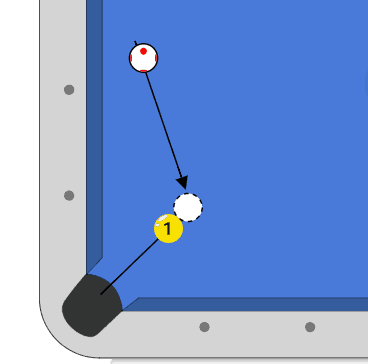
4. Have a stable hand bridge
The hand bridge can be one of the toughest things to learn when starting out pool. There are different variations of the hand bridge, but the 2 main ones are Open and Closed bridges.
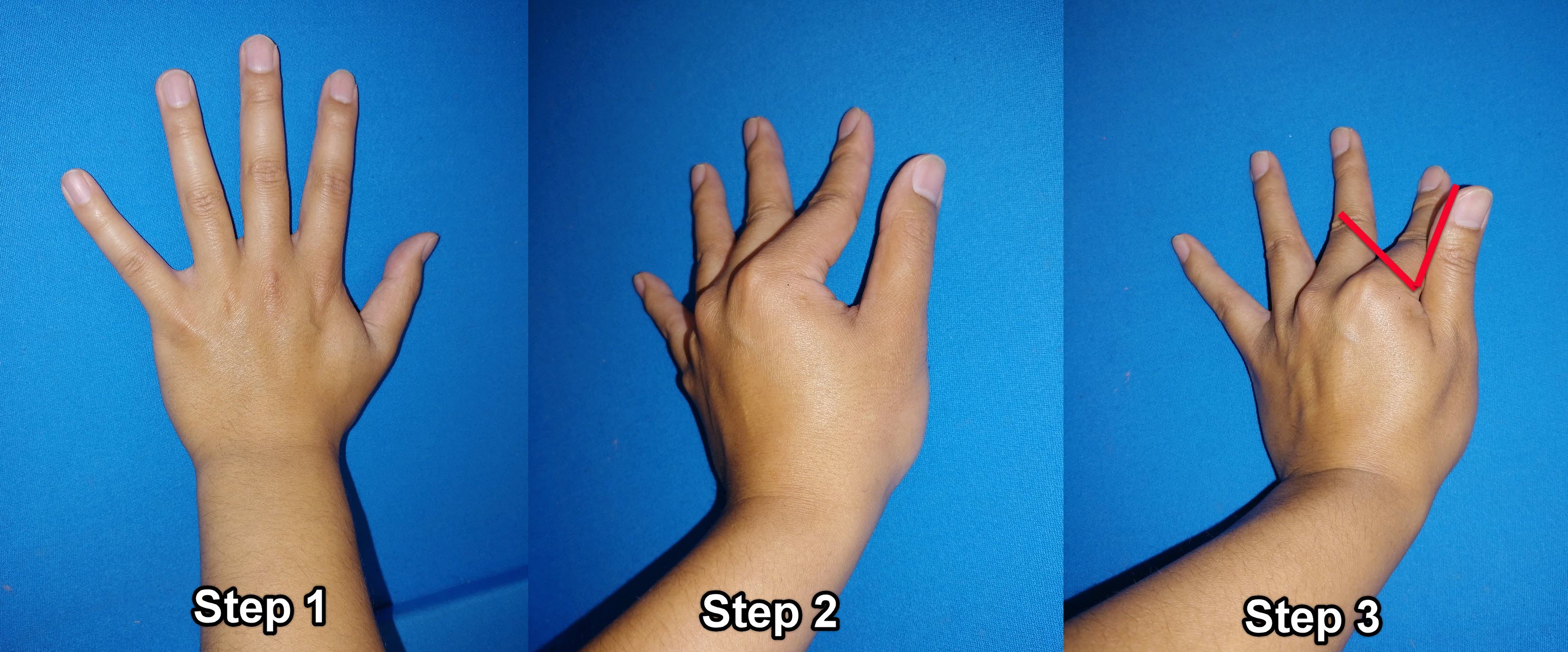
A hand bridge consists of your less dominant hand placed on the table (palm on the table) pushing your fingers together, pressing your thumb against your index (or middle) finger to create a “V”. Here is where you’ll place the cue. Make sure your bridge is stable and not easily moved to ensure a secure ‘bridge’ for your cue to slide on.
Check out my full article here on how to form a hand bridge in pool.
5. Your pool stroke is everything!
The stroke that you use will either limit or allow how far you can go in this game.
It is a huge core of your skill that you need to master in order to advance further. The perfect pool stroke is referred to as the pendulum stroke because you let your elbow behave as a hinge and your hanging forearm as a pendulum. Make sure your grip isn’t too tight and your practice strokes are steady and your cue tip is getting as close to the cue ball as possible.
Tip! You should only be moving your forearm and not your shoulder or chest.
6. Follow through on your shot
This is connected to #5 about your stroke, but in most of your shots, you will need to have a smooth follow through. This helps your stroke and apply whatever English you are trying to the cue ball.
This will also help with your aiming too because it will prevent you from veering off to the left or right when stroking and following through on your shot.
7. Don’t grip too tight!
I see a lot of new players use a strong grip on your stick and this will only hurt your game.
Don’t grip too tight! Unless you are using a specific stroke where you must use a tight grip, I promise you a majority of players use a soft grip with they cradle the cue in their fingertips. Usually, my cue hangs on my three or four fingers tips and my thumb is barely touching it.
8. How do I make Long shots in pool?
A lot of players struggle with long shots because of the increased distance, but that’s all in your head.
Some tips to overcome this are:
- Develop a good stroke to negate this
- Make sure you are aiming true center (if it’s a straight shot)
- Try some long shot drills
My favorite longshot drill is a simple one.
- Setup an easy straight in shot like below and make it.
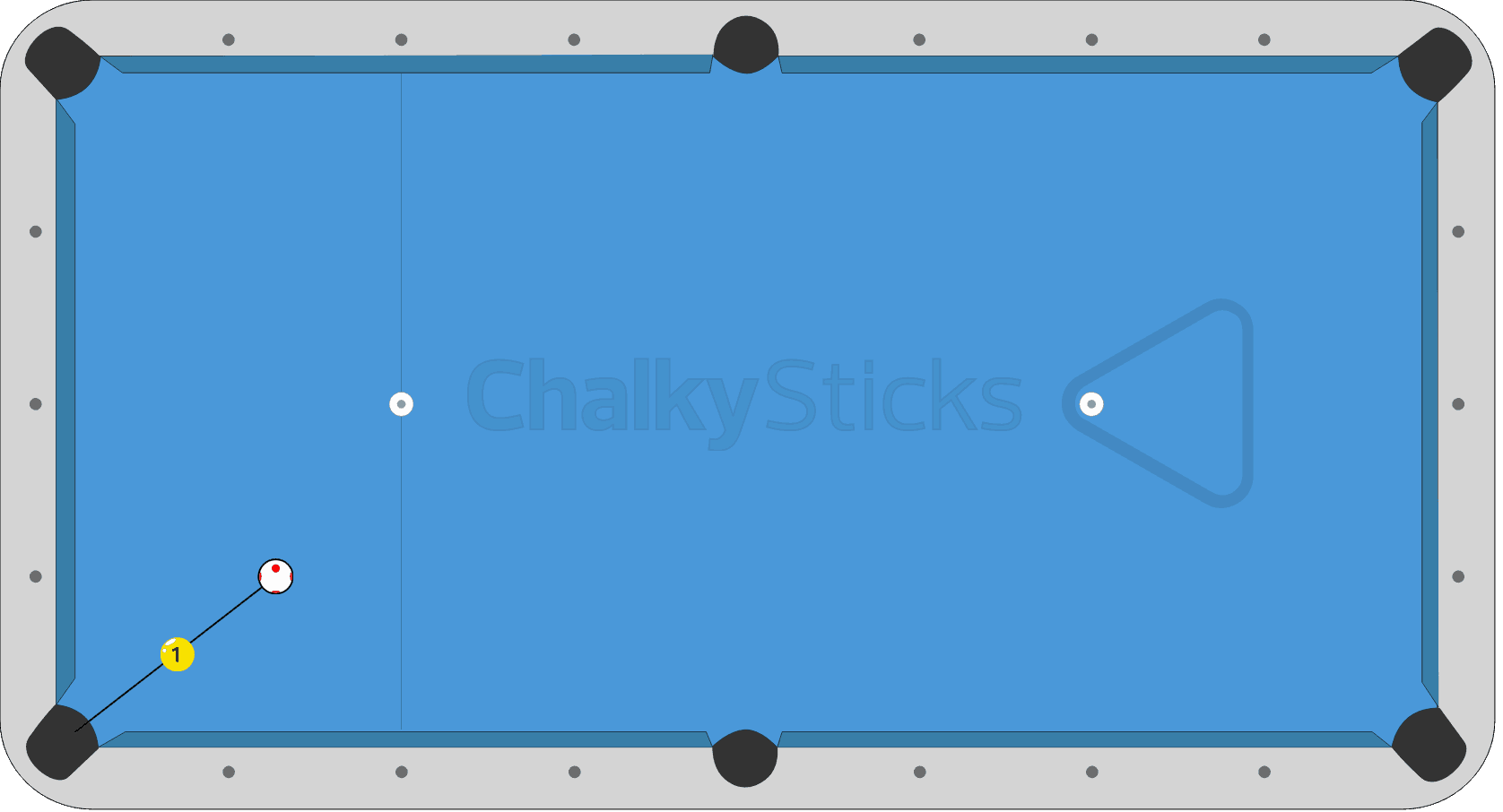
2. After you’ve made it, set up the same shot except move to the #2 position and make it.
3. Try making the same shot in all the numbered positions below:

If you miss at number 2 or 3 for example, try it again or even go back to a lower number. If you have a true straight and center stroke, the distance shouldn’t matter.
9. Make sure you are hitting Center
Are you really hitting the ‘center’ of the ball?
Many new players assume when the hit the cue ball, they are hitting in the middle – when in FACT they are hitting SLIGHTLY left or SLIGHTLY right. This small amount of English will change the impact of your shot making. Even the slightest English/Spin will transfer to that object ball you’re trying to hit and spin it away from the pocket.
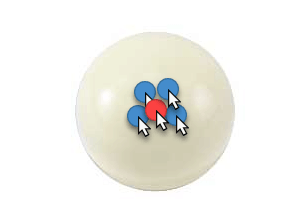
Practice it: Place the cue ball straight towards a diamond and hit it center and softly until it comes back to hit the tip of cue.

If it doesn’t hit your cue, you are not hitting center or your stroke is not straight. Practice this until you can get it 5x, 10x even 20x before ending the session.
10. Have Some Confidence in Yourself!
This isn’t a physical skill you can work on, but it’s an important one.
I’ve met a lot of great players who always doubted themselves whether it be making a hard shot or learning a new skill. It all starts with your mentality game, take a deep breath and have some confidence that you can defeat your opponent and that you can make this hard shot. It all starts with believing in yourself – you can do it!
- Don’t beat yourself up if you didn’t make a shot, take note of it and practice it later
- Take deep breaths
- Take your time
11. Why do I need to chalk in pool? Always Chalk!
You may see players chalk before every shot and it is a very good routine to develop.
The result of miscuing can be a game changer. This is very true if you are using side spin, drawing the ball back or whatever, just chalk before every shot. It is saving your pool life, trust me.
Chalk helps your tip grip onto that ball you are hitting. Remember that sometimes (when using spin or English), your entire tip is not actually hitting the ball, only parts of it. Chalk helps your tip and the cue ball get along!
Read my full post about Chalk here that goes over What exactly is Chalk, Why it’s important and my recommendations.
12. Learn other billiard games
It may not be common knowledge, but there are actually a ton of different variations of billiards. A short list would be:
- 8-ball
- 9-ball
- Straight pool
- Carom
- Snooker
The list goes on. The point is that each different game will make you think differently about how you approach pool and sharpen other skills. This will help you become an all-around good pool player prepared for a variety of different situations.
Now before we move on to the next 3 or 4 tips, I want to state that these next ones could easily be in the intermediate section – but I have seen beginner players learn certain stun or draw shots. It doesn’t mean they’ve mastered it fully but that they understand the basics of it so I wanted to include it here.
13. Don’t hit the balls too hard
Smashing the balls isn’t going to make your accuracy any better, it’s going to actually do the opposite.
Unless there is a very specific shot that absolutely requires you to hit harder, it’s best to dial it down and keep a natural or soft touch with the ball. We recommend using only the required amount of energy to make the shot desired.
14. Keep your cue level
You want to keep your stick as level as possible.
Make sure that you keep your cue level and parallel to the table. The more elevated and jacked up your stick is, the less likely it is you’ll make that shot. This is because it reduces your accuracy because you are shooting down on such an angle.
15. Stop/Stun shot
The stop or stun shot can be VERY useful in the game of pool.
There is also a lot of different ways to accomplish the stop shot. It is also important that if you want to execute a stop shot, you will need to have a straight in shot or else your cue ball will veer in the other direction if you have an angled shot.
These are the main 3 ways to accomplish the stop shot:
- Hitting dead center and following through
- What you want to do is hit dead center and make sure your stick follows through. Imagine you are hitting THROUGH the white ball and you want to see your stick extend beyond it. What players are doing incorrectly when they hit center softly is they don’t hit it hard enough or follow through which allows the ball to slowly roll forward.
- Slightly below center
- This is the same thing as above, follow through and hit it slightly firm. You don’t want to hit it TOO hard though or it will roll slightly back as you are hitting below center and not Center.
- Striking bottom with less energy
- If you hit this too hard, you will draw it back accidentally. This is a very soft shot and because the cue ball begins to lose its energy of the backspin you applied to it, it’ll “slide” right into the ball you’re hitting and stop. This is my favorite thing to do on long shots because I prefer not to hit it as hard when I can, and the first option (hitting dead center) requires more energy on a long stop shot.
- Hitting it very softly
- I wouldn’t recommend this that often unless it’s a easy shot and there isn’t much distance to cover. This is when you barely tap the cue ball to make the object ball in and the cue ball remains where you just hit. A lot of times this will easily roll slightly forward and you will scratch (especially if your object ball is sitting in the pocket).
TIP: Make sure your cue is as level as possible.
Want to see a video over this? Check out my YouTube channel Supreme Billiards where I have a video over this.
16. Follow through shot
The follow through shot in pool is great because if you need to roll the cue ball forward some more to setup for another shot, it gives you the distance to position there.
To execute this shot you’ll need to aim high and follow through. What a lot of player struggle with again is NOT following through and just hitting it harder – this is the WRONG way to do this.
- Aim high
- Follow through
You want to make sure your stick extends beyond the cue ball. Again, imagine you are shooting through the cue ball.
TIP: Make sure your cue is as level as possible.
Want to see a video over this? Check out my YouTube channel Supreme Billiards where I have a video over this.
17. Draw/Backspin shot
The draw or backspin shot is great because
- A. It looks cool
- B. It gets you great position on shots where you need to travel backward
To execute the backspin shot, you will need to aim low on the cue ball and make sure you follow through. It’s the same principles as the last 2 shots I just explained. These are things you do NOT want to do though:
- Jack up or elevate your cue (unless absolutely necessary)
- Forget to chalk before the shot
- You didn’t follow through, instead, you jabbed the shot and the cue stick barely moved forward
TIP: Make sure your cue is as level as possible.
Want to see a video over this? Check out my YouTube channel Supreme Billiards where I have a video over this.
18. Play more Defense/Safety
Defense wins games! A player that doesn’t have safety/defense shots in their artillery is limiting their pool game. If you can’t run out the entire rack, then it is recommended you play a defensive shot. This will ensure you get a next turn and hopefully a ball in hand.
Visit my full post about how to play defense/safety here.
19. Get a pre-shot routine down
It helps to have a pre-shot routine to create muscle memory when playing pool.
A pre-shot routine is a set of steps that you always take before making a shot. The pre-shot routine I recommend is:
- Evaluating the shot and identifying the shot line
- Getting into your pool stance and walking into the shot (Refer to my article here where I talk about pool stance if you need to know)
- Practice strokes 3 times (this can range on whatever you prefer, but 10 practice strokes is probably an overkill)
- Make the shot
- Stay down and in your pool stance for AT LEAST 2 seconds
*OPTIONAL* – Pausing right before you shoot (on the backswing or forward swing). Some players prefer this and some don’t – try it out and make sure it jives with what you feel comfortable with.
Fundamentals 2 (Intermediate)
These next tips will be for players who have some experience in the game but want to learn more.
Here we’ll go over the 30-degree and 90-degree rules and other systems that absolutely necessary to improve.
20. Have you heard of the 30-degree rule?
I know, numbers and degrees – what?
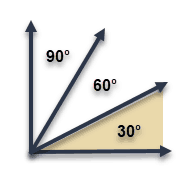
I promise you when I first heard about the 30-degree rule, it sounded silly to me. When I finally paid attention I quickly realized how important the 30-degree rule was. The 30-degree has elevated my game so much it’s ridiculous! To think that I never learned this easy trick to help me determine where the cue ball would go next has helped my positioning tremendously.
The 30-degree rule says that when a rolling cue ball shot happens; a majority of those angles will be very close to 30-degrees. This is rough angle when you make a “Peace sign” with your fingers.
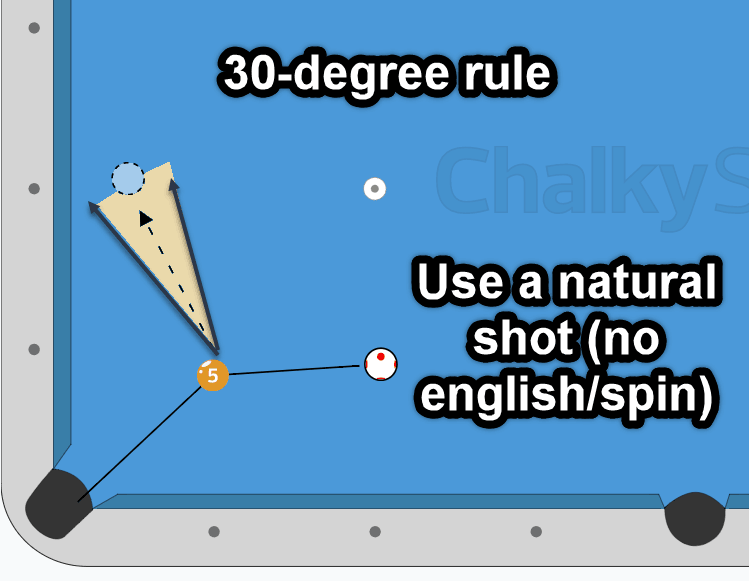
This means on most shots you naturally hit between ¼ of a ball and ¾ of a ball it will deflect at mostly a 30-degree angle (See Above highlighted area in the image). Learn this and practice it! I promise you it will be one of the greatest and fundamental things about pool you can learn.
21. 90 Degree Rule is your best friend
I’m killing you guys with these degree rule thingies – I’m sorry, but the 30 degree and 90 degree rules are like the golden rules of pool to me.
It’s gotten me out of so many situations or reinforced my confidence that I was NOT going to scratch in that pocket.
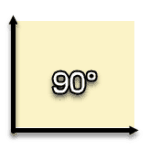
The 90-degree rule says that when you do a stun shot, your cue ball will deflect or separate at 90 degrees and it DOES NOT matter what angle your cut shot is at. The only exception is straight in shot.
Note: We just went over the stun shot earlier, scroll up if you missed it!
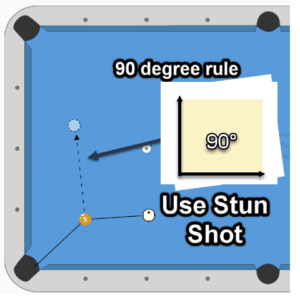
To help illustrate this, take the point where you need to hit that 5-ball in and make a “L shape” with your fingers (thumb and index). This should come out to a rough 90-degree angle. Place your thumb in line with where you’re aiming right at the object ball and where your pointer finger is going – is where the cue ball will go!
There is more to the 30-degree and 90-degree rule but this is the general gist of it. Most stun shots will work at most angles unless they are really steep or too full. Please do your own research and check other sources and fill that pool brain up!
22. Learn how to bank
Banking is when you make a ball by hitting it against the rails and going into a pocket.
A simple explanation to grasp this is to think of triangles. Every bank forms a triangle and if you can imagine equal lines from one end to the other end where the pocket is, it makes it simpler.

Banking in pool is very important. It can help when you have no other shot and it’s a must-have skill in your billiards arsenal.
This is one of the tips that I won’t get into too much explanation because of the numerous banking systems and a different number of approaches.
I will also create a stand-alone post in the future which will go more into detail later on. I advise you to look up what you prefer the most or even better – learn the system that the pro’s use.
Shameless Mika Plug
For me – I honestly prefer professional player Mika Immonen’s Mastering Pool DVD series. Here is a bundle for Volume 1, 2 and 3 on Pool Dawgs website for reference. This guy is an absolute monster at the game and I liked his clear-cut instructions, video quality, and overall content. He also explains how to run racks out and his thought process on how why he chooses each ball. Plus, it’s hard not to listen to a guy who has over 30 championship titles dating back since 2000 through 2016. This guy is a beast.
Whenever I am rusty in one part of my game, I refer back to a specific section in his DVD series and boom! Problem solved.
23. Learn rail shots
Everyone hates these shots, but they are shots just like any other shot. Some advice is to not overthink the distance your object ball needs to travel and focus on making the shot.
TIP: If the object ball is frozen on the rail (touching the wall) Try to imagine striking the ball AND the rail at the same time. This helped me a lot.
Advanced TIP: I put slight left or right english on these shots to help the ball spin into the pocket. It takes some practice but this is personally what I prefer. (Unless it will mess up my position)
24. Get your ball speed down
Have you ever hit a ball too hard or too soft which resulted in bad positioning for your next shot?
You need to fix your ball speed and I’ll show you how.
Here is a simple drill that I love because it requires very few tools. Got a piece of paper? Maybe one from your printer or a notebook? Grab that and get to the nearest pool table.
- Place your piece of paper in the #1 position.
- Hit the rail and try to make the cue ball come back and land inside or on the piece of paper
- Do this successfully at least 5 times.
- Move on to position #2 and then #3
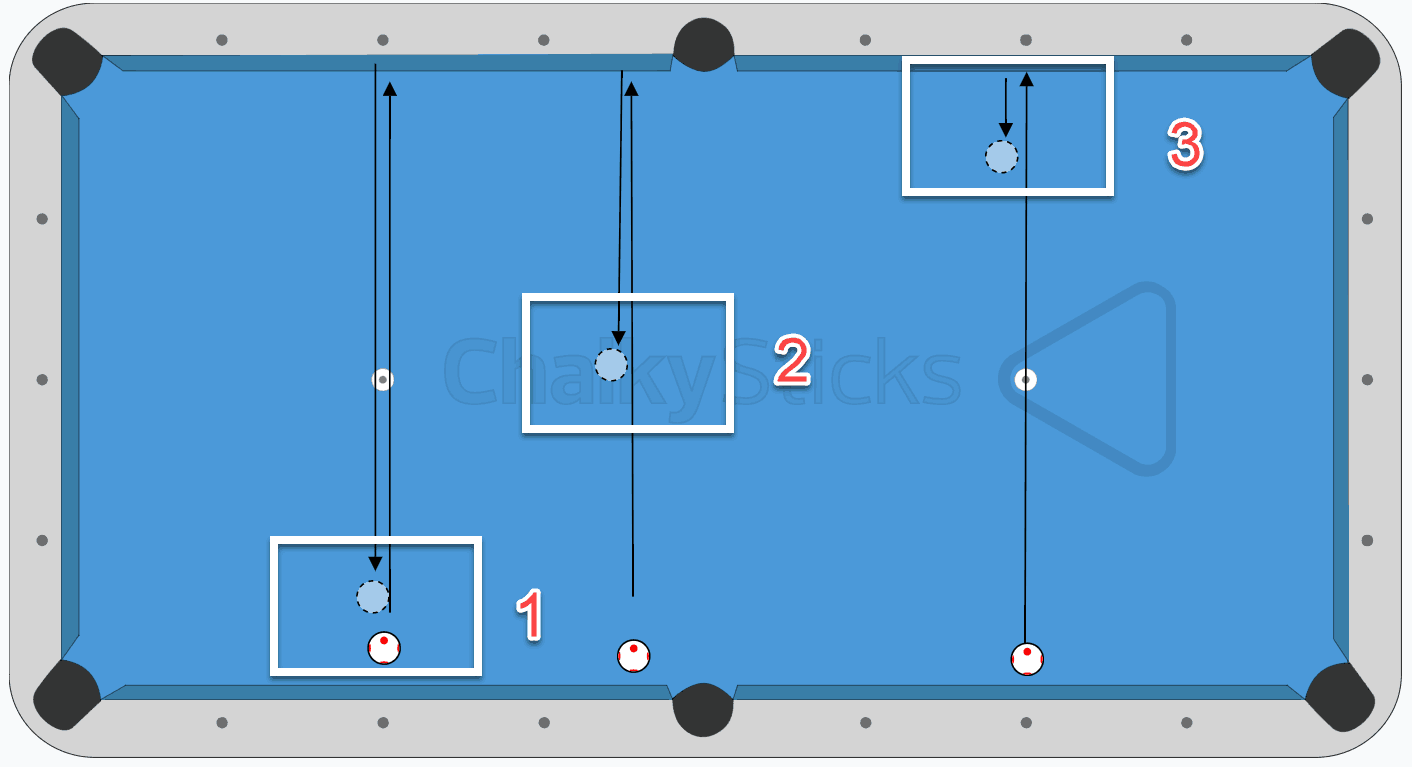
This is a great drill to do and will really help you determine how much energy to put into each shot to achieve the desired position and speed. Once you’ve completed all 3 positions, try experimenting and placing the paper in other positions that are more challenging.
25. Work on your positioning
How do I get the ball to go where I want it?
This goes hand in hand with your ball speed. Work on your positioning!
The first piece of advice I can say is to start by making most of your shots slowly and not hitting it too hard. This way you’ll learn the effects of how the ball rolls naturally.
I would advise the same drill I just listed above or this one below.
- Set up a shot similar to the example below
- Place a piece of paper in position #1
- Try to make the shot and land the cue ball within the piece of paper
- Do this 5x and move on to position 2
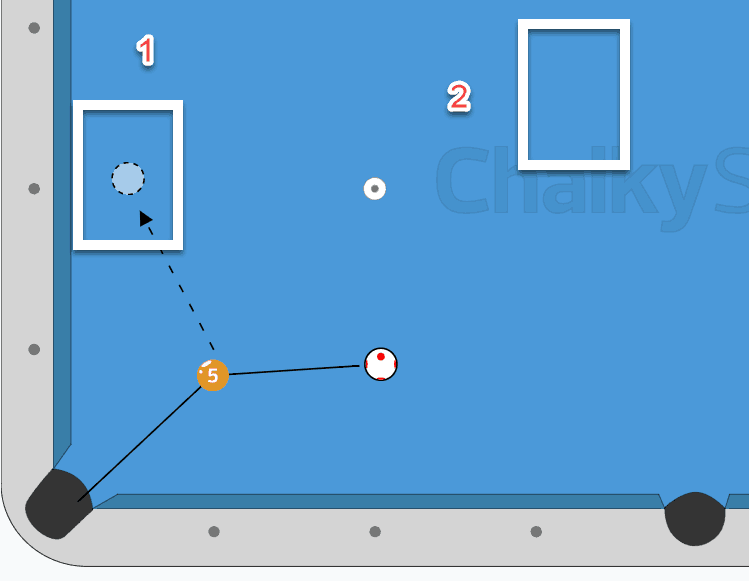
You may notice that the spin or English you put on a shot did not turn out how you thought it would. Maybe you hit it too hard or too soft. Make adjustments until you position it on the piece of paper. Once you’re done, move the piece of paper into harder spots and challenge yourself to try more difficult positioning.
26. Learn how to shoot elevated or jacked up shots
Sometimes you have to shoot really high shots/elevated shots because a ball is blocking your path where you would bridge normally. Some good advice is to overcome this is to:
- Strike downwards
- Strike more into the cue ball
This helps because most players miscue on elevated shots but are still aiming too high. This adds a higher chance of you mis-cueing and you do not want to do that!
Keep in Mind
Here are a few tips that aren’t directly going to improve your game but will improve it or give you more insight into the game. This will in result help you gather more knowledge around different aspects of pool which will help you in the end.
27. Try different pool cues
I have met a lot of players who have played with the same cue for 5 years, 10 years, 20 years and have never touched another cue.
That is okay – but what if they could improve their game by using another pool stick? I’m not saying that the pool stick is the main factor of if you’re going to win a game – but if you need help adjusting to deflection, then for example perhaps you may need to try a super low-deflection shaft.
Pool sticks are made of a variety of material and many different brands and companies produce different types of pool cues and products. I urge you guys to have an open and optimistic mind because there are some great pool products out there and they are only going to grow and get better with new technologies coming out every day.
28. Try different break cues
This is essentially the same advice as above except with break cues.
Breaking is a big part of pool and there are benefits of using other types of break cues. One example is using a break cue with a phenolic tip. Some say that it generates more speed and they are common on break cues. Just a heads up- it is a different feel and sound so it may get some getting used to but they work out great.
For tips on how to break, check out my article here.
29. Join a league
Joining a pool league was the best one decision I made in terms of improving as a pool player.
There are a ton of different pool leagues out there but my first one (and I’m sure a lot of people are in the same boat) was APA. This is natural because they are the biggest pool league out of the rest. The benefits include:
- Meeting new people in general
- Better players on your team able to teach and coach you
- Learning the rules of different formats
- Can be lots of fun
- May get money, paid trips and/or prizes (depending on the league)
There are probably other benefits but I can’t name them all. It’s just a great experience to be a part of.
Different types of leagues:
- APA
- BCA
- UPA
The list goes on. Do some research, google some places, talk to your local pool halls and find out what’s nearby your location.
Warning: Being on the right team is a 100% factor. Unfortunately, sometimes there can be unpleasant people and sometimes that is bound to happen. Just work with your league operator to figure out if there are any teams that need players or if you know a friend who is on a team with an open spot.
Read my full post about how to join a pool league here.
30. Join a pool forum
Pool forums are great because there are so much discussion and knowledge sharing in those threads.
The biggest pool forum out today is azbilliards.com and they dominate that world. I encourage you all to get into discussions about pool, what you love and hate about it. What your preference is on inlays on your pool cue or who is your favorite professional pool player. The topics are endless and it’s always great to share that passion with someone else.
31. Know the rules
Pool rules vary from league to league. They also vary game to game. The rules of 8-ball and 9-ball are veryyyy different. They will also post it on your leagues’ website (if you’re in a league). most of them aren’t too long, most pool games aren’t very complicated but league rules can be pretty complex with the different scenarios that can occur.
You want to make sure if there is a foul that has occurred – it is being called correctly.
32. What is the proper pool etiquette?
You never (I hope) want to offend other players while playing pool.
Many beginners don’t know all of the pool etiquettes because it’s so different from the normal bar tables and the bar rules. Here are some basics to stick to (especially if you plan to join a league or play competitively):
- Don’t go near the pool table when your opponent is shooting.
- This means not going to grab chalk, the bridge, etc.
- Quiet down! Don’t talk loudly or shout while your opponent is shooting
- Be polite -Shake your opponent’s hand before and after the game
- No drinks, smoking, or anything over the pool table.
- Let’s not paint the pool table with white – watch your hand chalk usage or get a glove
- Confirm the rules before any match, rules can change depending on location or format. It’s always good to double check.
- Be sure not to move around a lot, especially during your opponents shot and if you’re in their line of site
- Don’t get too upset. I’ve seen a lot of players get angry and break sticks – don’t be that guy
I know the pool halls can sometimes be an intimidating area at first – but I promise you that it’s easy to know the right guidelines on how to act when shooting pool. Just remember that playing in a league format is different from playing in a bar with some buddies. A league format or tournament is taken much more seriously among players.
33. Hire a professional pool or billiard coach
There isn’t a single professional athlete who hasn’t had a coach to help them along the way.
Do some research and find a coach who has years of experience that you personally like. There are a lot of options out there now with how powerful the internet is. Classes can get expensive depending on the level of the coach or experience – do what’s best within your budget.
34. Don’t use Side spin or English until you’re ready
Side spin or English is when you hit somewhere else besides the center of the ball. The change of direction you hit on the cue ball will change how it spins towards the object ball you’re hitting. It will also change how the object ball spins. Until you master the basics of pool, it’s best you do not try it in a real match until you are comfortable with it. To summarize it will:
- Change how the object ball spins (it’ll go opposite of what English you put on it. Ex: you put left English and the object ball will spin towards the right)
- The cue ball will take the direction of the English you put on it (if you put left English on the cue ball
This isn’t to say that you shouldn’t try it out on a practice table at your own leisure, but don’t run until you learn to walk first.
35. Take care of your equipment!
Keep your pool equipment well maintained. Here are some tips to help you with that:
- Don’t leave your sticks in really extreme hot or cold weather (get it out of your trunk and bring it in)
- Clean your cue routinely
- Make sure your tip has the ideal mushroom shape (or compared to a coin)
Smarter Pool
Playing pool isn’t about hitting the balls as hard as you can or making cool looking shots. If you approach pool like a chess match and spend sometimes to evaluate the different options, the game will reward you. Here are some tips I recommend for becoming a smarter pool player.
36. Recognize your break out or valuable balls
I have witnessed it too many times where players will shoot easy balls and ignore their problem ball. They leave it for the very end and then waste a shot breaking it out. If you can identify it early and then plan a way to break it out while making another shot – you are golden. Break your problem balls out and run that rack.
37. Take note of what you miss
This is so important and many players don’t do this.
Keep a note in your phone, write it down on a napkin or paper. All the billiard instructors will agree that if you miss a shot, remember it and practice it until you’ve overcome it. To improve as a player is to attack your weaknesses and overcome them.
38. Try to be creative
Explore a little bit. Try to churn those creative juices and try new things. It’s okay if you miss because you did it and you know how the ball behaved when you hit it a certain way. Some tips to help you be creative:
- Pretend other balls on the table are like rails, use them as stopping points for your cue ball
- Check out how to carom, it opens your set of options when shooting pool
- Learn how to bank and to do 2/3 rail kicks
These things are hard to master but it will help you to pull out those creative skilled shots that you see many advanced players do.
39. Use ball in hand wisely
Many players blow or waste their ball in hand on easy shots. Again, identify the HARDEST ball for you to make and take it out first. If you can’t run out the rack, then plan on playing safety on your first shot or soon after.
Don’t use ball in hand on a ball that’s hanging in the pocket unless your next shot is the 8-ball or you’re going to use it to break out another ball.
40. Leave an angle for your next shot
Angles is everything in pool! If you end up straight on every shot, you will limit yourself on your next positioning. Get familiar with angled shots and plan on setting your next shot as an angle shot.
41. Don’t waste too much time hitting balls, it’s not exactly practice
I know a lot of people who shoot around to “loosen up”. This is okay. But it’s when you say you are going to practice for a few hours but that results in you shooting pool with your buddies and having some beers.
This does not equate to real practice. You need to set aside 15 minutes, 20 minutes, even an hour or more of time to doing drills or learning new skills in pool.
42. You won’t improve by beating easy opponents
If you play the same people and you know you are better than them – this is not going to help you improve.
Play someone who is much better than you, and have them teach you a few things. Skilled players who have years of experience will know many little things about pool that you may not have thought of.
Mental Game
This is something I wanted to bring up because people forget how much of a mental game pool can be. Playing pool can stress you out and we don’t want that to happen.
43. Remain calm and keep a level head
I know sometimes in pool, it can drive you crazy and make you upset. You are not going to win every game you play, and that’s okay – it’s normal. Keep your cool and don’t be the guy who breaks a stick and gets kicked out.
44. Take your time
When you are shooting, don’t run up there to smash the ball in. Take your time, relax, the balls aren’t going anywhere.
45. Don’t rush
If you rush your shots, you are bound to mess up – guaranteed. This goes hand in hand with taking your time.
A good tip is counting to 3 after you are done shooting and staying DOWN in your pool stance.
- Shoot your shot
- Count to 3! 1…2…3!
- Get up
This looks like a simple plan, but trust me it can be really hard and you will find yourself becoming more and more impatient with each shot. Sometimes I knock it down to 2 full seconds and I still get the same effect, but I want you to try it at least 5 or 6 times and you will notice a difference immediately. This will help you take your time from shot to shot and remain calmer too.
46. Be Friendly
This probably shouldn’t be on here but I’m going to list it anyways – BE FRIENDLY!
Be nice, get a little social out there. Everyone is out here to have a good time. Some of my best pool friends I have are because I had the courage to go up to random folks and ask them if they wanted to play a game or to ask them how they made that cool shot or to just strike up a conversation!
A few benefits from my own experience is:
- I’ve met random people who eventually I asked them to join my pool team
- I learned something new from a much better player
- I was able to teach something to a beginner player
- Meet new people
Meeting new people can lead you to the craziest and most random things.
Part 2 of this is to always show your opponent respect (unless they’re being a complete jerk, then ignore them).
47. The biggest enemy is yourself
It sounds like a cliche quote but, it’s true.
You are your greatest enemy. It is the things like:
- the doubt you have in your head about shots
- the second-guessing to not listen to your gut
The list goes on. Take these steps to help:
- Evaluate the options you have to the best of your ability and go with probability. What are you most likely to make and still set up for your next shot? (Don’t go for that 1% 7-rail bank)
- Take a deep breath
- Come up with a phrase to repeat to yourself (“You got this Supreme Billiards, just take it nice and easy”)
I know a lot of it sounds cheesy, but in the end, it all helps. Do what helps you the most and make sure you’re still having a great time – win or lose.
48. Gamble a little
It’s good to play for a little bit of money to raise the stakes. This does a few things:
- It gets you practice playing under pressure
- Provides more motivation to play serious
I would advise not playing for more than $5 or $10 dollars but this is dependent on your disposable income.
Safety
These advanced tips are for the players who have a good sense of the game.
49. Learn some basic safety shots
DEFENSE WINS GAMES!! I will repeat this a million times until you take me seriously lol. If you cannot run the rack out with 100% confidence in yourself, you need to play defense. Learn some basic safety shots and check out my full post on here for more detail.
50. Learn 2-way shots
2-way shots are when you go for an aggressive shot to pot a ball or make a ball – and if you missed you would be setting your opponent up badly.
- If you make the ball – good, it’s okay
- If you didn’t make the ball – you left your opponent a hard shot
Keep this in mind because if you have options of which shots to make, and the hard one would still leave your opponent a nearly impossible shot to make; it might still be a good option to take that shot.
51. Leave the ball that’s in the pocket hanging
Sometimes its good to leave balls hanging just in case! A few examples of why are:
- It blocks your opponents ball
- Help set up for the next shot
- Blocks the pocket from other balls* (depending on the opponents skill level, they might be able to follow their ball in after they make yours)
You don’t always have to shoot the easy balls first. If your ball is hanging in the pocket and it’s an easy one to make, you may want to leave it there if your opponents ball is right next to it and has nowhere else to go.
There may also be a situation where that hanging ball can help you position for your other balls. Don’t take the easy one if it’s gonna leave you in a bad spot afterward!
That’s all the tips I have for now. Thanks everyone for reading and I hope these tips help you improve!

